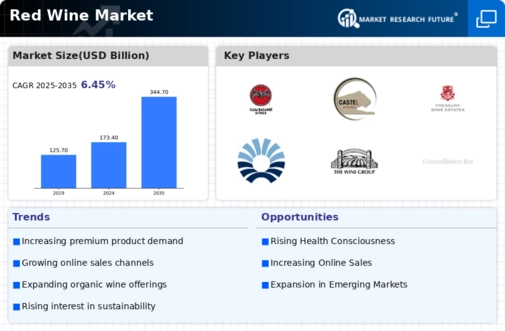Top Industry Leaders in the Red Wine Market

Strategies Adopted by Red Wine Key Players
The Red Wine market is characterized by its rich heritage, diverse varietals, and a discerning consumer base. This analysis provides insights into the key players, strategies adopted, market share dynamics, emerging companies, industry trends, current investments, the overall competitive scenario, and a notable development in 2023.
Key Players:
Accolade Wines (Australia)
Amvyx SA (Greece)
Bacardi Limited (Bermuda)
Gruppo Campari (Italy)
Castel Group (France)
Compagnia Del Vino SRL (Italy)
Treasury Wine Estates (Australia)
Pernod Ricard (France)
The Wine Group (US)
Constellation Brands (US)
Caviro (Italy)
Vina Concha y Toro S.A. (Chile)
E & J Gallo Winery (US)
Grupo Penaflor S.A. (Argentina)
Diageo plc (UK)
Strategies adopted by key players in the Red Wine market center around product diversification, brand building, sustainability, and digital innovation. Recognizing the increasing consumer interest in diverse wine experiences, companies invest in cultivating a broad range of red wine varietals. This approach ensures that they cater to a wide spectrum of consumer tastes and preferences.
Brand building is pivotal in the wine industry. Establishing a strong brand identity, often tied to a specific terroir or winemaking tradition, fosters consumer trust and loyalty. Red wine producers leverage their heritage, unique winemaking processes, and distinctive regional characteristics to differentiate themselves in a crowded market.
Sustainability practices, including organic and biodynamic viticulture, resonate with environmentally conscious consumers. Key players are incorporating sustainable farming methods, eco-friendly packaging, and renewable energy initiatives to align with the growing demand for environmentally responsible products.
Digital innovation is becoming increasingly important, especially in reaching and engaging with consumers. Key players invest in e-commerce platforms, social media marketing, and virtual tasting experiences to connect directly with consumers, enhance brand visibility, and adapt to changing consumer behaviors.
Market Share Analysis:
Several factors contribute to market share dynamics in the Red Wine market. Quality and consistency of the wine produced play a crucial role in building and maintaining market share. Companies that prioritize stringent quality control measures and uphold winemaking traditions tend to garner consumer trust and loyalty.
Distribution networks are paramount. Companies with well-established and efficient distribution channels, spanning both traditional and online retail, can ensure their red wines are readily available to consumers globally. Strategic partnerships with restaurants, hotels, and wine retailers contribute to broader market coverage.
Consumer education is integral in a market where consumers often seek information about grape varietals, regions, and tasting notes. Companies that invest in consumer education through wine clubs, online content, and interactive experiences create a knowledgeable consumer base that is more likely to explore and appreciate their offerings.
News & Emerging Companies:
News in the Red Wine market often revolves around new vineyard acquisitions, partnerships, and innovative winemaking techniques. Emerging companies in this sector frequently focus on niche markets, introducing unique varietals, and experimenting with fermentation processes to stand out in a competitive landscape.
Industry news also centers around technological advancements in winemaking, including the use of artificial intelligence for vineyard management and fermentation optimization. Emerging companies, often more agile in adopting new technologies, leverage these innovations to enhance efficiency and product quality.
Industry Trends:
The Red Wine market highlight a commitment to sustainability, technology, and market expansion. Sustainable practices extend beyond the vineyard to winery operations and packaging. Companies invest in solar energy, water conservation, and eco-friendly packaging to reduce their environmental impact.
Technological investments focus on precision viticulture, where data analytics and sensors aid in optimizing grape cultivation. This data-driven approach enables companies to make informed decisions about irrigation, pest control, and harvest timing, ultimately enhancing the quality of the grapes and, subsequently, the wine.
Market expansion remains a key trend, with companies exploring opportunities in both established and emerging wine markets. Investments in new vineyards, winery facilities, and partnerships with local producers contribute to a broader market presence.
Competitive Scenario:
The Red Wine market presents a competitive landscape where heritage, quality, and innovation are pivotal. Established players with a global reach leverage their extensive resources to dominate key markets. However, emerging boutique wineries often find success by focusing on unique offerings, storytelling, and personalized customer experiences.
The industry's adaptability to changing consumer preferences, such as the growing interest in organic and natural wines, underscores its resilience. Red wine producers that can balance tradition with innovation, while addressing sustainability concerns, are well-positioned to thrive in the evolving market.
Recent Development
The Red Wine market was the increased emphasis on transparency and traceability. Key players introduced initiatives to provide consumers with detailed information about the origin of grapes, winemaking practices, and even the carbon footprint of the production process. This development aligns with the growing consumer demand for authenticity and sustainability, indicating a positive shift towards more transparent and eco-conscious red wine options.


